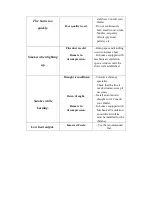
• When the stove body is very hot, close the lower control.
• The burning rate can now be lowered by moving the top air control to smaller air
inlet.
Re-fuelling
Figure 8
• Slide the top air control to open. Open the lower control.
• Open the glass door and add logs. (To load fuel, the door should be opened slowly,
avoiding a sudden rush of intake air, so that smoke does not escape into the room.)
• Leave the lower control open for a few minutes to allow the initial volatiles in the
wood to burn.
• Close the lower control.
Very Important:
Wood is a material that contains a great deal of gas (approximately
75 %). The gases are released when the wood is lit and heated up. For this reason, it is
important that the gases are ignited quickly after stoking. If the wood just lies
smouldering, especially after re-stoking, a lot of smoke is created, which, in the worst
case, may cause an explosive ignition of the gasses, resulting in damage to the stove.
In order to ignite the gases that are released from the wood, and to keep clear, lasting
flames during the combustion process, it is important to let in the required quantity of
oxygen (air supply) at all times. The setting of the air supply, the method of ignition
and the lighting intervals depend on the draught in the chimney, the wind and weather,
the amount of heat required, the fuel, etc. This means that it may take some time
before you get to know the correct functioning of the stove under any given
circumstances
3.2.2 Use with Solid Fuel
Lighting
Figure 8
• Slide the top air control to open. Open the lower control.
• Lay firelighters or rolled up newspapers on the grate with a reasonable quantity, if
necessary, of dry kindling wood. Place a small quantity of solid fuel on top.
• Light the newspaper or firelighters using a long taper and close the door.




































